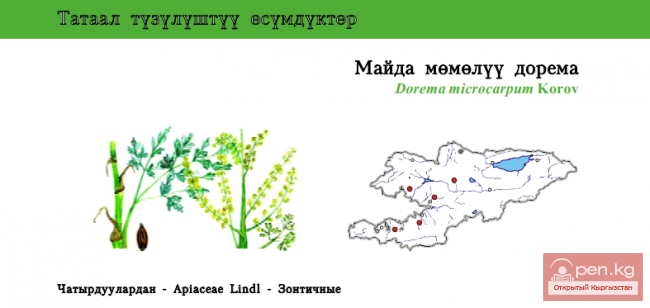
html Korshinsky’s Meadow Saxifrage Status: EN. A rare endemic species found in small numbers and...

Insect species excluded from the Red Data Book of Kyrgyzstan Insect species excluded from the Red...

Intermediate Hyalolaena Status: VU. Endemic. One of three species growing in Kyrgyzstan....

Insect species listed in the 2004 IUCN RLTS, not included in the Red Book of Kyrgyzstan 1....

Rosetted Thorough-wax Status: VU. Rare species. One of six species of the genus found in...

Species of higher plants removed from the "Red Book" of Kyrgyzstan (1985) Species of...

Dorema microcarpum Status: VU. Rare endemic species....

Broad-stamened Tulip Status: VU. A narrow endemic of the Alai Ridge....

Sclerotiaria pentaceros Status: CR B2ab(iii). Endemic to a monotypic genus....

Kosopoljanskaya Turkestanian Status: VU. One of the two endemic species of this genus found in...

Wolly-fruited Kosopoljanskia Status: EN. Endemic. One of the two species that are sub-endemic to...

Cnidiocarpa alaica Status: VU. A rare representative of a monotypic genus....

The project "USAID Business Development Initiative" (BGI), within the tourism...

Eremurus Zenaidae Status: VU. Endemic to the lower and middle belts of the Fergana and Alai...

Schennikov’s Otostegia Status: VU. A rare endemic species, endemic to Kyrgyzstan with a disjunct...

Knorring’s Larkspur Status: VU. A rare ornamental relic species with a disjunctive range, endemic...

False Hooked Fumitory Status: VU. Endemic species of the Pamir-Alai....

Vvedensky’s Sage Status: VU. A very rare narrowly endemic species. An ornamental plant....

Korzhinski’s Pear Status: VU. One of three species growing in the territory of the Kyrgyz...

Middle Asian Pear Status: EN. The species is little-known and narrowly localized, endemic to the...

Rhodiola litwinowii Status: LC. A mosaic-distributed species, intensively used in agriculture....

Hairy Flowering Plant Aulie-Ata Status: EN. A representative of a monotypic section, a narrowly...

Edelweiss-like Pyrethrum Status: VU. Endemic species....

Kashgarian Barberry Status: VU. Rare species....

Tianschaniella umbellifera Status: VU. A significantly declining narrowly endemic species of...

Kolpakovski’s Tulip Status: VU. An endemic of the Northern Tien Shan with a decreasing population....

Knorring’s Haw-tree Status: VU. A narrowly endemic species....

Anomalous Alajja (Erianthera anomala) Status: VU. Endemic to the mountains of Central Asia. A rare...

Golden Trichanthemis Centaury Status: VU. A rare narrowly endemic species of the Alai Ridge, an...

Poet B. Sarnogoev was born on January 14, 1932, in the village of Budenovka, Talas District, Talas...

Prose writer and critic D. Kazakbaev was born on June 20, 1940, in the village of Dzhan-Talap,...

Eremurus zoae Status: VU. A narrowly endemic species of the Kyrgyz Range....

Susamyr Catchfly Status: EN. A rare species found in small numbers and in a limited area, which...

Alai Centaury Status: VU. Endemic species....

Kaufmann’s Tulip Status: VU. An endemic species of the Western Tien Shan. Highly decorative: the...

Poet and prose writer T. Miyashev was born in the village of Papai in the Karasuu district of the...

Persian Rowan Status: VU. Endemic, ornamental species....

Kolyuchelistnik kachimovidny Status: VU. A species with a rapidly reducing range. The roots of...

Pskem Onion Status: EN. A very rare species with a shrinking range in the Western Tien Shan....

Pink Tulip Status: EN. A narrowly endemic species of the foothills of the Turkestan Range, sharply...

Menzbier’s marmot Status: V category, Vulnerable, VUB1+2c. Rare species. Endemic to the Western...

Catmint-like Scullcup Status: VU. A very rare narrowly endemic species. Ornamental plant....

Uzun-Akhmat Grape Status: VU. Endemic species of Western Tien Shan....